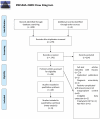Chinese herbal medicines for the treatment of type A H1N1 influenza: a systematic review of randomized controlled trials
- PMID: 22164232
- PMCID: PMC3229517
- DOI: 10.1371/journal.pone.0028093
Chinese herbal medicines for the treatment of type A H1N1 influenza: a systematic review of randomized controlled trials
Abstract
Background: Chinese herbs are thought to be effective for type A H1N1 influenza. Series of Chinese herbs have been authorized recommended by the Chinese government, and until now a number of clinical trials of Chinese herbs for H1N1 influenza have been conducted. However, there is no critically appraised evidence such as systematic reviews or meta-analyses on potential benefits and harms of medicinal herbs for H1N1 influenza to justify their clinical use and their recommendation.
Methods and findings: CENTRAL, MEDLINE, EMBASE, CBM, CNKI, VIP, China Important Conference Papers Database, China Dissertation Database, and online clinical trial registry websites were searched for published and unpublished randomized controlled trials (RCTs) of Chinese herbs for H1N1 influenza till 31 August, 2011. A total of 26 RCTs were identified and reviewed. Most of the RCTs were of high risk of bias with flawed study design and poor methodological quality. The combination of several Chinese herbal medicines with or without oseltamivir demonstrated positive effect on fever resolution, relief of symptoms, and global effectiveness rate compared to oseltamivir alone. However, only one herbal medicine showed positive effect on viral shedding. Most of the trials did not report adverse events, and the safety of herbal medicines is still uncertain.
Conclusions: Some Chinese herbal medicines demonstrated potential positive effect for 2009 type A H1N1 influenza; however, due to the lack of placebo controlled trial and lack of repeated test of the intervention, we could not draw confirmative conclusions on the beneficial effect of Chinese herbs for H1N1 influenza. More rigorous trials are warranted to support their clinical use.
Conflict of interest statement
References
-
- Narain JP, Bhatia R. Influenza A (H1N1): responding to a pandemic threat. Indian J Med Res. 2009;129:465–7. - PubMed
-
- World Health Organization. Pandemic (H1N1) 2009 - update 84. 2009. Available: http://www.who.int/csr/don/2010_01_22/en/index.html. Accessed 2010 Jan 24.
-
- Center for Desease Control and Prevention. Seasonal Influenza (Flu). 2009–2010 Influenza Season Week 19 ending May 15, 2010 Antiviral Resistance. 2010. Available: http://www.cdc.gov/flu/weekly/. Accessed 2010 May 20.
-
- Moscona A. Oseltamivir resistance-disabling our influenza defenses. N Engl J Med. 2005;353:2633–2636. - PubMed
-
- Ministry of Health of the People's Republic of China. Guidelines for Management of Pandemic (H1N1) 2009 Influenza. 2009. Available: http://www.moh.gov.cn/publicfiles/business/htmlfiles/H1N1/s10628/index.htm. Accessed 2009 Oct 13.
Publication types
MeSH terms
Substances
LinkOut - more resources
Full Text Sources
Other Literature Sources
Medical


